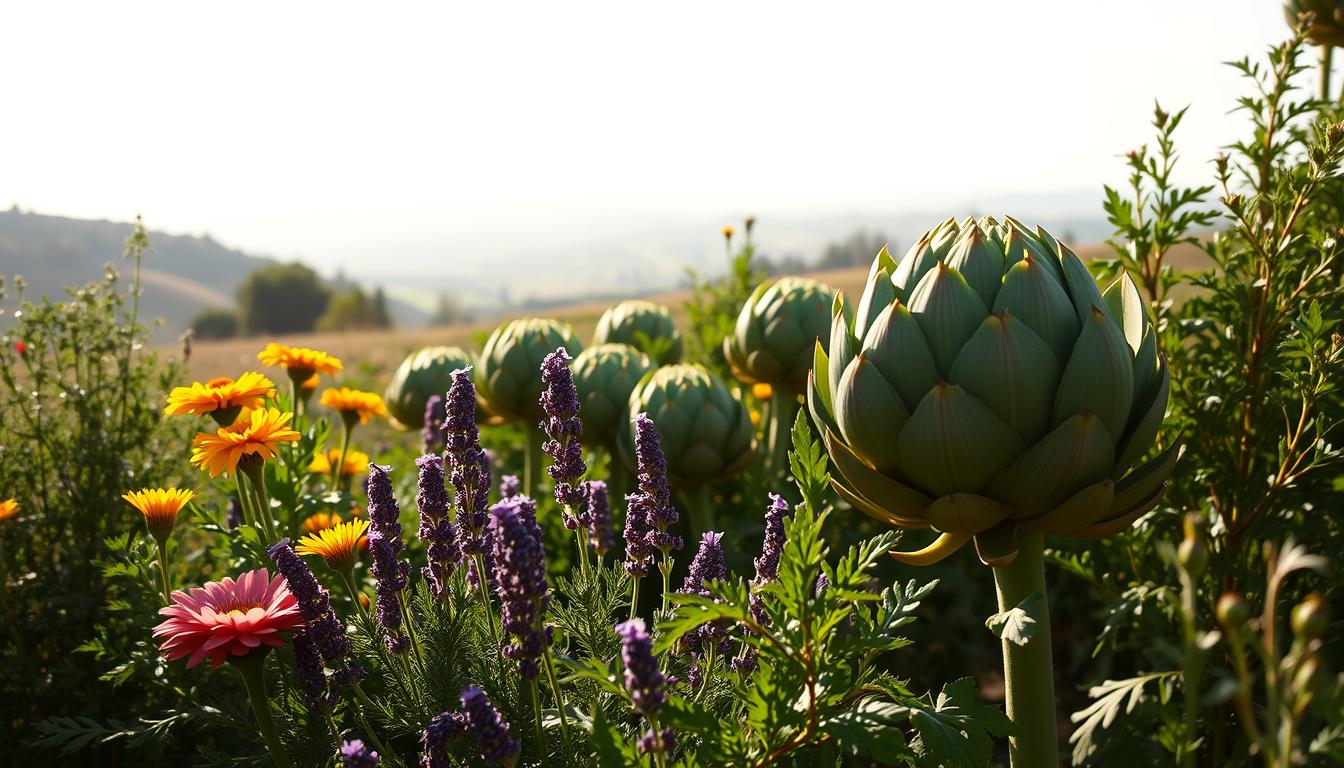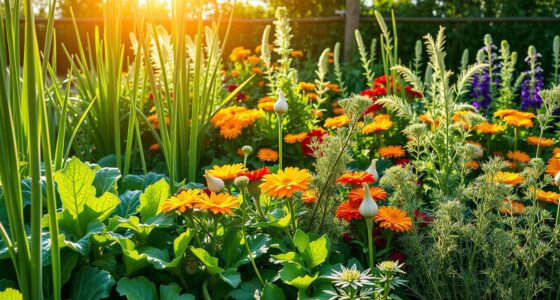When you think of your garden, what images come to mind? Perhaps it’s the vibrant hues of blooming flowers or the delicious aroma of fresh herbs wafting through the air. For many of us, planting artichokes is more than just a gardening endeavor—it’s a way to connect with nature, nurture life, and savor the joys of homegrown flavors. As you embark on the journey of growing artichokes, understanding the role of companion plants can profoundly impact your experience. By choosing the best companion plants for artichokes, you can enhance their growth, flavor, and resilience, ensuring a thriving garden that brings you joy and bountiful harvests.
In this article, we’ll explore the essential companions that not only thrive alongside artichokes but also help you maximize your gardening efforts. You’ll discover the benefits of growing artichokes with companions and how the right plant relationships can lead to healthier crops. Let’s dive into the world of artichoke companion plants and create a flourishing garden together!
Key Takeaways
- Artichokes thrive when paired with the right companion plants.
- Companion planting enhances growth, flavor, and pest management.
- Choosing the best companions maximizes your gardening success.
- Understanding plant relationships can lead to healthier crops.
- Integrating companion plants creates a vibrant, diverse garden.
Why Companion Planting Matters for Artichokes
Companion planting plays a vital role in the successful cultivation of artichokes. This technique involves growing different plants side by side to promote beneficial interactions that enhance growth, flavor, and pest control. Understanding the artichoke companion planting tips can significantly improve your gardening experience and yield. By pairing artichokes with compatible plants, you harness the numerous benefits of companion planting.
Benefits of Companion Planting
Engaging in companion planting can lead to healthier plants and increased productivity. Artichokes benefit greatly when grown alongside nitrogen-fixing plants such as peas. This partnership enriches the soil, allowing your heavy-feeding artichokes to thrive. Furthermore, companion planting reduces competition for resources, ensuring that all plants have the essentials they need to grow strong.
Enhancing Growth and Flavor
When you strategically place artichokes with complementary plants, you can improve not only their growth but also their flavor. Certain herbs, like basil, can enhance the taste of artichokes when planted nearby. These plants work in harmony, providing each other with the nutrients they require while boosting the overall garden ecosystem.
Pest Control with Companion Plants
One of the most significant advantages of companion planting is its role in pest management. Certain companion plants can attract beneficial insects such as ladybugs and lacewings that keep pest populations in check. By incorporating this practice into your gardening routine, you can create a natural barrier against harmful pests that threaten your artichokes.

Ideal Soil Conditions for Artichokes
Creating the right soil environment is essential for growing healthy artichokes and maximizing their potential. Understanding nutrient requirements and pH levels significantly contributes to the success of your artichoke garden, ensuring ideal artichoke companions thrive alongside.
Nutrient Requirements
Artichokes are heavy feeders, which means they require nutrient-rich soil to support their growth. A well-balanced fertilizer that includes nitrogen, phosphorus, and potassium provides the nutrients your artichoke garden partners need. Regular applications of organic matter, such as compost, enhance soil fertility and improve drainage.
pH Levels for Optimal Growth
The pH level of your soil plays a critical role in nutrient absorption. For optimal growth, the ideal pH range for artichokes falls between 6.5 and 7.5. Maintaining this balance allows your plants to efficiently take up the essential nutrients, supporting robust health and productivity. Test your soil conditions regularly to make adjustments as needed, ensuring a thriving environment for your artichoke plants.

| Nutrient | Ideal Range | Source |
|---|---|---|
| Nitrogen | 50-100 lbs/acre | Organic fertilizers, compost |
| Phosphorus | 20-40 lbs/acre | Bone meal, rock phosphate |
| Potassium | 25-75 lbs/acre | Wood ash, potash |
Top Companion Plants for Artichokes
Choosing the right artichoke plant companions can significantly boost the health and productivity of your artichokes. Companion planting with artichokes involves pairing these unique plants with others that support their growth, repel pests, and attract beneficial insects. Below is a look at some of the best partners for your artichokes.
Herbs That Pair Well
Certain herbs make excellent companions for artichokes. Their aromatic properties not only enhance flavors but also deter harmful pests. Consider planting:
- Basil: Known for repelling whiteflies and aphids.
- Rosemary: Its strong scent keeps pests at bay.
- Thyme: Attracts pollinators while warding off unwanted insects.
Compatible Vegetables
Incorporating vegetables that thrive alongside artichokes can create a harmonious ecosystem. Look for:
- Tomatoes: They share similar water and nutrient needs.
- Peppers: These companions flourish in similar conditions and benefit from the shade artichokes provide.
Flowers to Attract Beneficial Insects
Colorful flowers can really make a difference in your garden. Plants like marigolds and borage attract beneficial insects, enhancing the overall health of your plants.
- Marigolds: They draw in pollinators and natural predators of pests.
- Borage: Known for attracting bees and butterflies, which assist in pollination.

Herbs That Complement Artichoke Growth
Integrating herbs into your garden can significantly enhance the growth of artichokes. These aromatic plants not only provide culinary benefits but also contribute to the health of your garden through artichoke companion planting. Here are three herbs that are particularly effective in supporting your artichoke plants.
Basil and Its Benefits
Basil is a wonderful companion for artichokes, renowned for enhancing their flavor. The aromatic oils in basil can deter pests such as aphids and spider mites, making it a valuable ally in your quest for growing artichokes with companions. Additionally, basil thrives in similar soil conditions, ensuring a harmonious relationship in your garden.
Rosemary’s Role in Companion Planting
Another exceptional herb is rosemary, which complements the taste of artichokes. Rosemary attracts beneficial insects, such as ladybugs, which feed on harmful pests. Planting rosemary close to your artichokes not only enhances flavor but also helps maintain a balanced ecosystem, essential for successful growing artichokes with companions.
Oregano’s Pest-Repelling Qualities
Oregano stands out for its ability to repel unwanted insects that can threaten artichoke plants. By planting oregano alongside your artichokes, you create a natural barrier that discourages harmful pests from invading. This pest-repelling quality makes oregano an ideal candidate for artichoke companion planting.
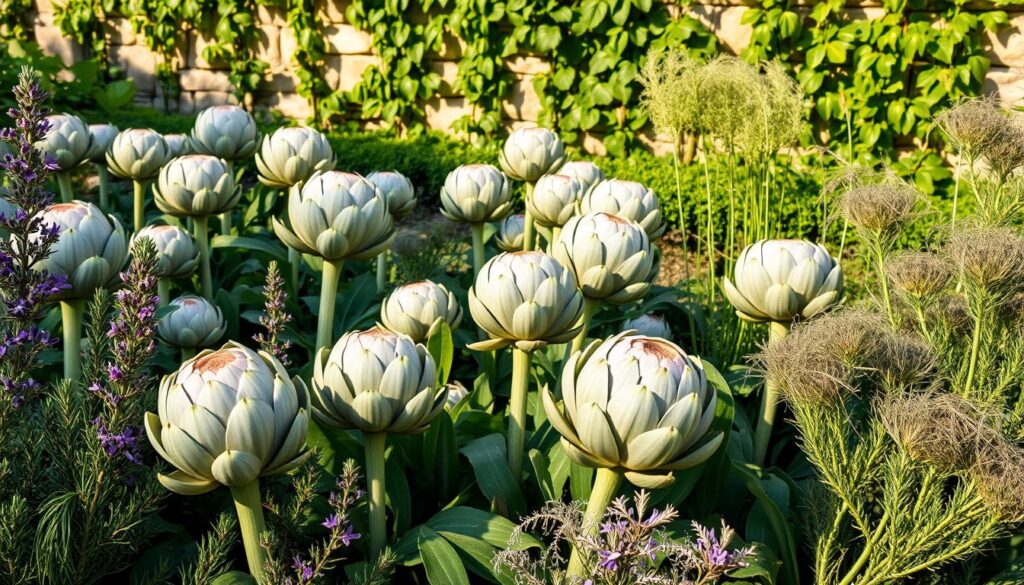
Incorporating these herbs into your garden can improve the health and resilience of your artichokes. As you experiment with growing artichokes with companions, you will discover the intricate connections that can enhance both your garden’s productivity and your culinary creations.
Vegetables That Thrive Near Artichokes
Creating an artichoke garden is not just about the artichokes themselves. Choosing the right vegetables to plant nearby can significantly enhance your garden’s productivity. Two excellent candidates that fit well into the best companion plants for artichokes are tomatoes and peppers. Both of these vegetables thrive alongside artichokes, providing mutual benefits.
Tomatoes: A Delicious Duo
Tomatoes serve as fantastic companions for artichokes. They grow well together thanks to similar cultural requirements such as water, sunlight, and soil type. Tomatoes can provide partial shade to the artichokes during the hotter months, which helps mitigate stress on the plants. This combination ensures not only a bountiful harvest but also flavors that complement each other beautifully, making them perfect additions to various dishes.
Peppers as Supportive Neighbors
Peppers benefit from the presence of artichokes as well. Both plants have similar nutrient requirements, making their coexistence more efficient. Peppers can thrive in the same soil conditions as artichokes, fostering a symbiotic relationship in your garden. The artichoke garden pairings with peppers result in vibrant colors and flavors, enhancing your culinary options during harvesting time.

Pest and Disease Management for Artichokes
Artichokes are known for their unique flavor and tenderness, but they can attract pesky intruders such as aphids and slugs. Implementing effective pest management is essential for maintaining healthy plants. Companion planting with artichokes can be an excellent strategy for enhancing resilience against these nuisances. By choosing the right companion plants, you can create a thriving ecosystem that works in your favor.
Common Pests and How to Combat Them
Aphids and slugs, among other pests, can pose significant challenges to your artichoke growth. Monitoring your plants for early signs of infestations is key. If you notice aphids, consider introducing natural predators like ladybugs to your garden. For slugs, you can use barriers such as copper tape or simply hand-pick them during your garden check-ins.
Planting Allies to Deter Pests
Integrating companion plants is one of the best artichoke companion planting tips. For instance, planting marigolds nearby can deter nematodes and attract beneficial insects that help manage pest populations. Borage attracts pollinators and may also discourage aphids. By fostering these plant partnerships, you create a protective environment that minimizes health risks for your artichokes.

| Pest | Companion Plant | Benefits |
|---|---|---|
| Aphids | Borage | Attracts pollinators and may dissuade aphid presence. |
| Slugs | Marigolds | Deter nematodes and attract natural predators. |
| Nematodes | Nasturtium | Can repel nematodes and attract predatory insects. |
Flowers That Attract Pollinators
Incorporating the right flowers into your garden can significantly enhance the health and yield of your artichoke plants. Selecting flowers to attract beneficial insects plays a crucial role in creating a vibrant ecosystem. Pollinators, such as bees and butterflies, help ensure that your artichokes receive the pollination necessary for optimal growth.
Marigolds and Their Advantages
Marigolds are excellent companions for artichokes, bringing a burst of color and vitality to your garden. These flowers not only attract beneficial insects but also deter some harmful pests. By planting marigolds nearby, you provide an inviting environment for pollinators, which can lead to increased artichoke yield and overall plant health.
Borage for Bees and Butterflies
Borage stands out as a magnet for various pollinators. The vibrant blue flowers of borage draw in bees and butterflies, essential for effective pollination. By including borage amongst your artichoke companion plants, you create a more diverse garden that can enhance fruit and vegetable quality. Pollinators thrive with access to such flowers, making your efforts rewarding and fruitful.
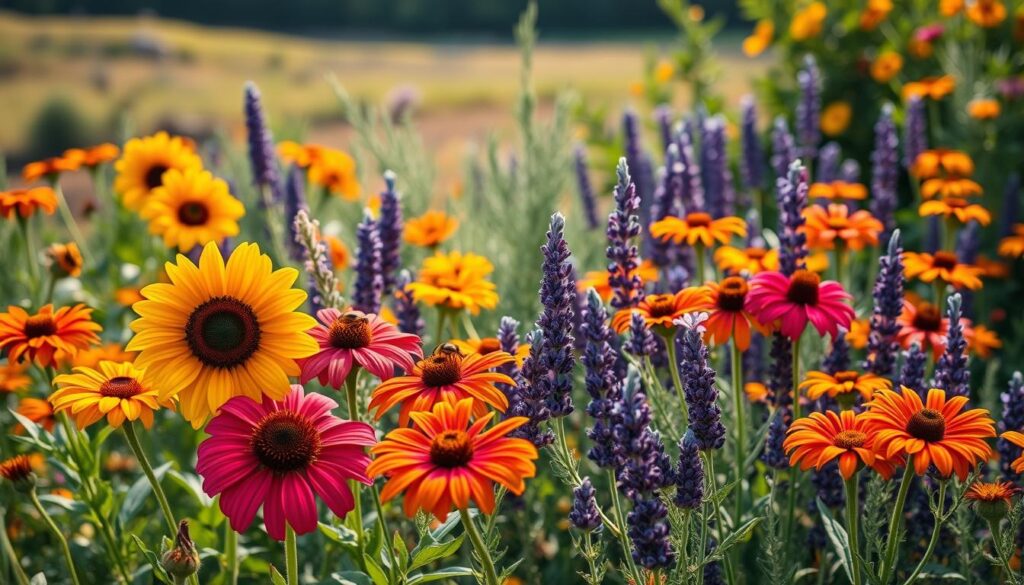
Avoid These Plants with Artichokes
Certain plants can adversely affect the growth of your artichokes. To create a thriving artichoke garden, it’s essential to recognize those species that do not coexist well with artichoke garden partners. By eliminating these competitors from your garden, you can ensure a healthier environment for your artichokes to flourish.
Plants That Compete for Nutrients
Some plants require a significant amount of nutrients, which can lead to competition with artichokes. It’s advisable to avoid plants such as:
- Corn
- Potatoes
- Beets
These heavy feeders might deplete essential soil resources needed by your artichokes to thrive.
Allergens That Can Affect Growth
You should also consider allergens that may impact your artichoke garden. Certain beans might create an unfavorable growing environment. It’s best to avoid plants with artichokes that may introduce allergens into the local ecosystem. This practice can lead to a healthier growth process for your artichokes.

Artichoke Planting Techniques
Mastering the right planting techniques is vital for nurturing artichokes alongside their optimal artichoke companions. Proper spacing allows each plant to thrive without overshadowing its neighbors. As artichokes can expand up to 4 feet wide, understanding how to strategically place companion plants can enhance your garden’s productivity and overall health.
Optimal Spacing for Companion Plants
When planning your garden, consider how much space artichokes will require. Maintaining adequate distances between plants supports healthy growth and allows good air circulation. Here are some spacing guidelines for both artichokes and their companions:
| Plant Type | Recommended Spacing (in feet) |
|---|---|
| Artichokes | 3-4 |
| Herbs (e.g., Basil, Oregano) | 1-2 |
| Tomatoes | 2-3 |
| Marigolds | 1-2 |
Timing Your Planting Schedule
Successful artichoke companion planting hinges on timing. You should plan your planting schedule around your local climate. Some general tips include:
- Start artichoke seeds indoors about 8 to 10 weeks before the last frost.
- Transplant seedlings outside after the threat of frost has passed.
- Introduce companion plants at various intervals to maximize the benefits from compatible species.

Seasonal Care for Artichoke Companion Plants
To ensure robust growth and optimal yields from your artichoke garden, understanding seasonal care for artichokes is essential. Proper watering and fertilization techniques can significantly impact the development of both artichokes and their companions. Following these expert tips will help you create a thriving garden.
Watering Guidelines
Artichokes require deep and consistent watering throughout the growing season. Implementing a drip irrigation system is an excellent choice since it provides moisture directly to the roots and avoids wetting the foliage. This practice reduces the risk of diseases such as mildew and rot. Aim to water your plants at least once a week, adjusting based on rainfall and soil moisture. Mulching around the base helps retain soil moisture and regulates temperature, benefiting your artichoke companion planting tips.
Fertilizing for Best Results
Fertilizing every four to six weeks with a balanced organic fertilizer can significantly enhance the growth of your artichokes and their companions. Rich in nitrogen, phosphorus, and potassium, these nutrients are crucial for healthy foliage and vigorous production. Consider using compost or well-rotted manure to enrich the soil, promoting a sustainable approach to seasonal care for artichokes. These organic amendments not only nourish your plants but improve soil health over time.

Harvesting Artichokes and Their Companions
Knowing the right time and method for harvesting artichokes enhances the overall quality of your yield. Artichokes are best harvested when their buds are firm and tightly closed. Observing these signs ensures a flavorful and delicious addition to your meals. Carefully managing the harvest not only benefits the artichokes but also the various artichoke garden partners that support growth and health in your garden.
Knowing When to Harvest
The ideal time for harvesting artichokes typically ranges from late spring to early summer, depending on the variety and growing conditions. Look for the following indicators:
- The flower buds should be plump and tightly closed.
- Flowers that begin to open indicate they are past their prime for harvesting.
- Select buds that are 3 to 5 inches in diameter for the best flavors.
Tips for Harvesting Without Damage
To ensure both artichokes and their garden partners thrive, follow these tips during the harvesting process:
- Use a sharp knife or pruning shears to cut the stem at an angle, minimizing potential injury to the plant.
- Aim to harvest in the morning when plants are well-hydrated for easier cutting.
- Be gentle around the base to avoid disturbing neighboring plants and soil structure.

Storing and Preserving Artichokes
After your successful harvest of vibrant artichokes, it’s essential to know how to keep them fresh and flavorful. Proper techniques for preserving artichokes can enhance their longevity while maintaining their quality. Understanding ways to store artichoke companion plants is equally important to ensure your garden remains productive and tasty.
Best Practices for Storage
To maintain the freshness of artichokes, store them in a cool, dry place. Ideal conditions involve slightly humid environments to avoid wilting. Keep artichokes in a perforated bag in the refrigerator for optimal storage, allowing air circulation while maintaining necessary moisture levels. Freezing is a popular method for long-term preservation. Simply blanch the artichokes before freezing, ensuring they retain their vibrant color and flavor.
Creative Ways to Use Your Harvest
Using your harvested artichokes can be both fun and delicious. Consider making artichoke dips or incorporating them into salads for a healthy addition. You can also try pickling artichokes as a tangy side dish. Incorporate these delicious veggies with your favorite stored artichoke companion plants, enhancing the flavors and creating a culinary adventure right in your kitchen.
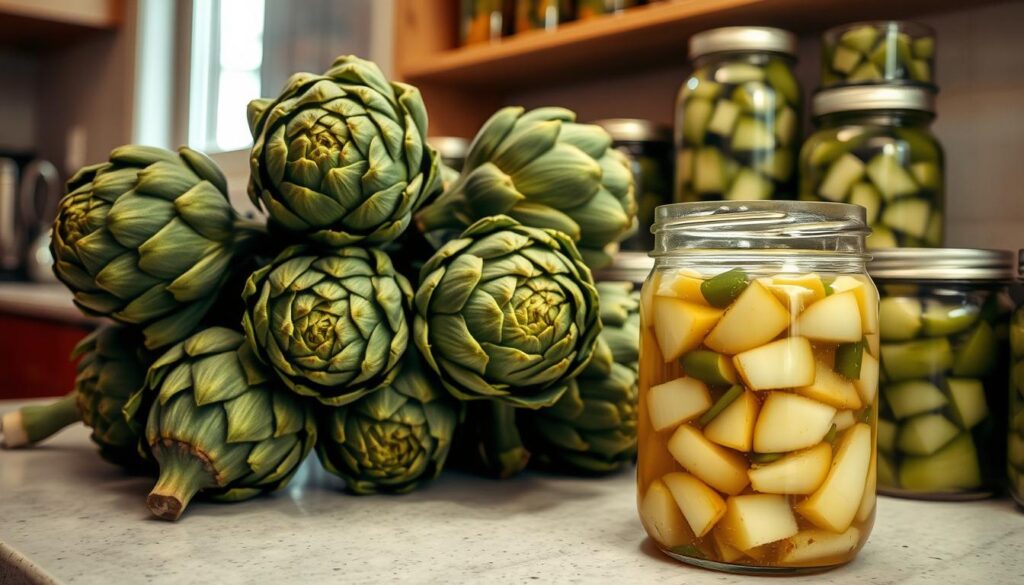
Incorporating Companion Plants in Your Garden
Creating a thriving garden ecosystem begins with an effective layout. When incorporating artichoke companions, consider the arrangement of your plants to maximize their benefits. Position taller artichokes where they can provide shade for smaller plants, facilitating diverse growth while optimizing space. This thoughtful design enhances not only aesthetics but also crop productivity by catering to the unique needs of each plant.
Designing a Companion Planting Layout
Planning your garden layout involves understanding the growth requirements of each species. For artichoke companion planting tips, opt for plants that flourish in similar soil and light conditions. You might consider using trellises for climbing beans alongside your artichokes, ensuring they receive enough sunlight while benefiting from the microclimate created by the larger plants. A well-structured scheme will lead to improved yields and healthier plants.
Tips for Rotating Crops
Crop rotation is essential for maintaining soil health and preventing issues like nutrient depletion and soil-borne diseases. Shift your planting arrangement yearly to give artichoke companions a chance to rejuvenate the soil. Rotate your crops to alternate between heavy and light feeders, ensuring a balanced nutrient profile in your garden. Apply these artichoke companion planting tips consistently to see an improvement in overall garden vitality.

Troubleshooting Common Issues
Encountering problems with your artichokes can be a frustrating experience. Recognizing early signs of distress and knowing how to respond can make all the difference in maintaining a thriving crop. You will find that troubleshooting artichokes involves observing plant health closely, ensuring you identify any potential growth problems efficiently.
Identifying Growth Problems
Look out for yellowing leaves, stunted growth, or wilting as these may indicate nutrient deficiencies or other underlying issues. Pests such as aphids or spider mites can create further complications. Regularly inspect your plants, focusing on their overall vitality and the condition of nearby artichoke garden partners. Signs of neighboring plants suffering can also alert you to potential problems affecting your artichokes.
Adjusting Care for Better Results
Once you’ve identified the issue, adjusting care becomes essential. If nutrient deficiency is suspected, consider applying organic fertilizers tailored for artichokes. If pests are detected, prompt action in the form of natural insecticides or introducing beneficial insects can assist in managing the situation. Ensuring that your artichokes receive consistent and appropriate watering can also enhance growth, leading to a healthier harvest.

Future Trends in Companion Planting
As the gardening community becomes more aware of environmental issues, the future trends in companion planting are leaning heavily towards sustainable gardening practices. Researchers are diving into the science of how plants interact, uncovering new beneficial pairings that promote healthy ecosystems within gardens. The focus has shifted from just growing plants side by side to understanding their interconnectedness.
Research Developments
Ongoing studies are revealing innovative combinations of plants that not only improve soil health but also enhance pest control naturally. By exploring these relationships, gardeners can learn which plants work best together, creating vibrant and robust ecosystems. Understanding these dynamics leads to healthier plants and a more efficient use of resources.
Sustainable Practices Making Waves
Sustainable gardening practices are gaining traction as gardeners seek to maintain harmony with nature. Techniques like organic pest management and soil enrichment through companion planting reduce the need for chemical interventions. Embracing biodiversity in the garden fosters resilience against pests and disease, contributing to overall sustainability.

Final Thoughts on Growing Artichokes with Companions
As you reflect on your artichoke gardening journey, it’s clear that embracing diversity in your garden can lead to a flourishing ecosystem. Artichoke companion planting not only increases your yield but also elevates the aesthetic appeal of your space. Choosing the right companions ensures that your artichokes receive the nutrients they need while deterring pests and inviting beneficial insects.
Embracing Diversity in Your Garden
By incorporating a variety of plants around your artichokes, you’re nurturing a balanced environment that can support both growth and health. This diversity can create a resilient garden where each plant plays a role in enhancing the others. The myriad of colors, shapes, and sizes in your planting scheme will also make your garden visually captivating.
Enjoying the Fruits of Your Labor
Ultimately, the final thoughts on artichokes revolve around the satisfaction they’ll bring you. When your plants thrive alongside wise companions, you’re rewarded with flavorful artichokes and an abundant harvest. This journey is about more than just gardening; it’s an opportunity to enjoy the rich rewards of your efforts—both in taste and in the joy of cultivating your patch of nature.
